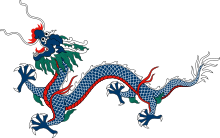 The Azure Dragon depicted on the flag of the Qing dynasty | |
| Grouping | Mythical creature |
|---|---|
| Sub grouping | Dragon |
| Folklore | Chinese mythology |
| Country | China |
The Chinese dragon (Chinese: 龍; pinyin: lóng), also loong, is a legendary creature in Chinese mythology, Chinese folklore, and Chinese culture at large.[1] Chinese dragons have many animal-like forms such as turtles and fish, but are most commonly depicted as snake-like with four legs. Academicians have identified four reliable theories on the origin of the Chinese dragon: snakes, Chinese alligators, thunder worship and nature worship.[2] They traditionally symbolize potent and auspicious powers, particularly control over water.[3]
- ^ Lau, Chris (16 February 2024). "Happy New Year of the Dragon - or should that be 'Loong'?". CNN. Retrieved 19 February 2024.
- ^ Meccarelli 2021, pp. 123–142.
- ^ Carlson, Kathie; Flanagin, Michael N.; Martin, Kathleen; Martin, Mary E.; Mendelsohn, John; Rodgers, Priscilla Young; Ronnberg, Ami; Salman, Sherry; Wesley, Deborah A. (2010). Arm, Karen; Ueda, Kako; Thulin, Anne; Langerak, Allison; Kiley, Timothy Gus; Wolff, Mary (eds.). The Book of Symbols: Reflections on Archetypal Images. Köln: Taschen. p. 48. ISBN 978-3-8365-1448-4.
